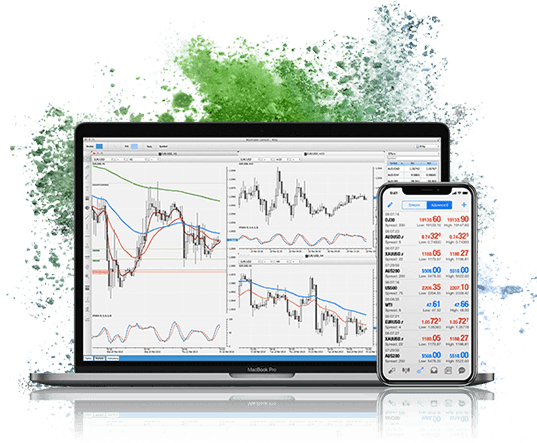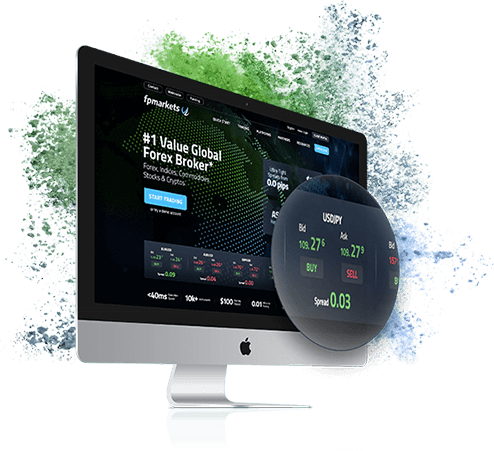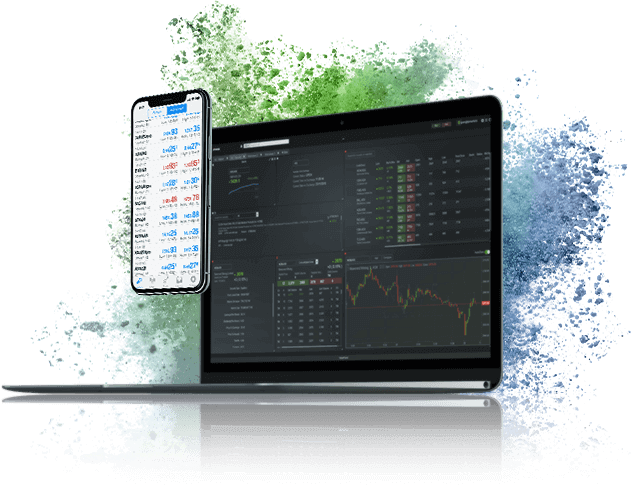What is Margin in Trading?
Things You Need to Know
Margin trading is a popular concept that has made it possible for retail traders to trade in various financial securities including forex, metals, commodities, indices and cryptocurrencies. Margin trading allows for significantly higher exposure with limited capital. Traders are required to deposit only a fraction of the total value of their trades which enables them to adequately diversify their portfolio for the purposes of risk management. While margin trading offers several advantages, it is not without risk. Higher exposure may magnify potential profits from favourable market moves, but also increases the level of risk. For the effective use of margin trading, it is necessary to look at how it works, its benefits, and risk management tools that can be utilised to help protect traders from inherent risks.


What is Margin?
The term margin is widely used in the field of finance and refers to the amount by which the value of a collateral provided for a loan exceeds the loan amount. The term is now being increasingly used in trading and has come to mean the amount that needs to be deposited by traders or investors to gain exposure that is much higher than the funds available in their account. The margin is a fraction of the total value of the exposure and the remaining amount is funded by the broker.
It can be thought of as taking a loan from the broker, hence the term margin loan. In this case, the underlying security acts as the collateral for the loan. This concept of taking a higher exposure is called leverage, which is used widely by seasoned traders. For new traders, it is highly recommended to gain a good understanding of the pros and cons of margin trading or trading with leverage before venturing into this space.
How Does Margin
Trading Work?
Let’s understand margin trading with the help of an example. Let’s say a trader wishes to gain exposure to company A’s stock and its share price is $30. The trader is very bullish about the share price rising and has $1,200 to invest. After a week, the market moves as per the trader’s expectations, and the stock price rises to $40.
Without Margin Trading
The trader would have been able to purchase only 40 shares. When he sells the shares at $40, he earns $1,600 ($40 per share x 400 shares) and makes a profit of $400 ($1,600-$1,200).
With Margin Trading
The broker offers the trader leverage of 10:1. What this means is that the trader can gain exposure ten times the amount of his investment. So, when he invests $1,200, he can purchase shares worth $12,000 or 400 shares of company A.
When he sells the shares at $40, he receives $16,000 ($40 per share x 400 shares). He makes a profit of $4,000 ($16,000-$12,000) by investing only $1,200.
Margin trading is possible in currencies, stocks, precious metals, commodities, indices, and cryptocurrencies. The financial instrument that allows the use of high leverage is CFDs. The level of leverage offered on each instrument may differ based on the market conditions and factors affecting the price of these instruments. Most importantly, the level of leverage offered depends on the broker.
Traders can choose the leverage as per their financial goals and risk appetite. Through the use of leverage, traders can increase their buying power, but should always be aware that the same applies to risk and potential losses.

How is a Margin
Account
Different
from a Cash Account?
A cash account is an account offered by a broker without any borrowing options available. All transactions performed using this account need to be paid in full at the time of the execution. In contrast, a margin account is one where the broker allows traders to deposit only a certain percentage of the total value of a transaction. The remaining amount is provided by the broker as a loan. The borrowed money needs to be repaid to the broker. Transactions may incur brokerage fees such as margin interest.
What are the
Different Types of
Margin Trading?
Margin trading involves different types of margins:
Initial Margin
This is the initial amount deposited by the trader into their trading account and is decided by the margin requirement set out by the broker. Your broker will specify the initial margin amount that you need to deposit in your live trading account. Not all brokers are authorised to offer margin trading or deal in highly leveraged products like CFDs. Before you open an account with a broker, enquire about the margin trading requirement and what leverage they offer. Also, ensure you trade with a licensed and regulated broker, as they would follow stringent protocols to safeguard the interest of traders.
Maintenance Margin
This refers to the minimum balance a trader must have in their trading account at all times. If the balance in your margin trading account falls below the maintenance margin, your broker can issue a margin call. This margin is used to protect the broker from incurring losses arising from traders defaulting on payments.
Variation Margin
This refers to changes in the margin requirements that occur because of price fluctuations in various securities. Let’s say a trader leaves a trade overnight and its price rises from your initial investment of $1,500 to $2,000. This means the trader has made a profit of $500. However, if the investment value falls to $1,000, it means the trader has incurred a loss of $500, which needs to be compensated. In such a situation, the trader is required to meet this shortfall by depositing funds in their live trading account and holding onto the position.
Margin Call
When the trader’s account does not have sufficient funds to cover the losses incurred in various trades, it triggers what is known as a margin call. This is the requirement of paying the shortfall amount into the trading account. Let’s say the margin requirement of a trading account is $500 and the trader has incurred losses so that the account balance falls to $400. A margin call is triggered for the trader to deposit $100 into his trading account, allowing the trader to maintain his initial margin requirement of $500.
In such a situation, the trader can either close his trade, reduce his exposure by freeing up some equity in his account or adding funds into his account. However, if the trader is unable to respond to the margin call and deposit the necessary funds in his account, the broker can sell the contract on behalf of the trader and adjust the losses incurred from the initial margin funds.
As a trader, it’s a good idea to keep a close eye on your account and ensure that you do not face a margin call. The more established brokers incorporate advanced features in their trading platform that allow traders to easily view their account details and set up alerts to maintain their margin requirement.
Leading forex trading brokers offer a stop out at 50% the margin level. When your account reaches that level, your trades are automatically closed, starting from the trades with the largest loss. Such brokers allow your margin level to fall to 100% before triggering a margin call.
How is the Margin
Amount
Determined?
Margin trading works by allowing a trader to open a position by committing only a small percentage of the total transaction value. The margin amount is determined by the margin requirements set by the broker, while the capital requirement is determined by the instrument being traded. Financial instruments that involve higher volatility or large positions often require a larger deposit in view of the high risk involved. Different brokers offer different levels of leverage for varied instruments and the level of leverage decides the margin requirement. For instance, if a broker offers leverage of 100:1, it means the margin requirement is 1%, while if the broker offers leverage of 10:1, the margin requirement is 10%.
What is the Cost of
Using
Margin Trading?
Margin trading is a form of borrowing from the broker. Due to this, it may involve certain costs. While the financial instrument being traded becomes the collateral, the primary cost to the trader is the interest. The interest charges are applied to the trading account unless the trader decides to make payments. You can find brokers that do not charge any interest on the leverage offered.
What are the
Advantages of
Margin Trading?
Margin trading allows traders to gain a higher exposure to various financial instruments by depositing only a percentage of the total value of the trades. This type of trading offers advantages such as:
Trading on margin can magnify the profits since they are calculated on the total value of the trade and not the amount deposited in the margin account.
Margin trading allows traders with limited capital to diversify their positions across several markets.
Margin trading or leverage allows traders to gain exposure to even expensive instruments.


What are the
Risks Involved in
Margin Trading?
While allowing traders to take a much higher exposure than the funds available in their live account, the concept of margin trading comes with some risks. Traders need to be aware of these before they start trading and develop adequate risk management strategies. The risks associated with margin trading are:
There is the possibility of higher losses. A higher exposure brings with it chances of both higher profits and higher losses. When the market moves in the anticipated direction, the trader records profits. However, if the market moves in the opposite direction to what one had expected, the trader will incur losses. Both profits and losses in margin trading are calculated on the total value of a trade and not the margin funds. Therefore, the losses will also be larger when the market moves against you. It is highly recommended to use risk management tools to protect yourself from undue losses in margin trading.
There is the possibility of a margin call. A sudden margin call means the trader needs to add more funds to their trading account to maintain their open trades. Failure to do so may result in the broker closing the positions.
Some brokers allow traders to use the securities to cover for the shortfall. This, however, is not permitted with CFDs or other forms of derivatives trading. This is because such instruments give traders exposure to the rise or fall in the price of an asset without involving the buying and selling of the underlying asset. Since the trader does not own the asset, they cannot use it to cover the shortfall in their account.
How to Manage the
Risks Involved in
Margin Trading?
The risks in margin trading can be managed by following a sound risk management strategy. Here are some tips:
Learn about the financial instruments you wish to trade:
For instance, if you wish to trade CFDs, you should know what a CFD is and how it can help you identify opportunities in both rising and falling markets. As a trader, you can open both a long position or short position. CFDs are a unique financial instrument that allow you to gain access to stock markets and global financial markets without owning the security.
Invest according to your risk bearing capacity:
A basic principle in trading is to identify how much risk you are willing to take and trade accordingly. Make a realistic assessment of how much funds you can afford to lose on any one trade to determine the size of your position.
Don’t let emotions guide your trading decisions:
Set aside a specific amount for trading. When the market moves favourably, traders often get greedy and begin opening larger and larger positions with the aim of making money quickly. This can backfire if the market suddenly moves against your trades. And, with margin trading, your losses are magnified. So, decide the amount of funds and the strategy before you begin placing trades.
Avoid using the full leverage being offered by the broker:
The use of leverage is very common in the forex market but traders should think carefully about how much they wish to use. New traders can begin with low leverage and small trading positions. They can increase the amount of leverage and size of trade as they gain experience and become better versed with the way financial markets function. Do check the terms and conditions for different levels of leverage offered by your broker before you enter a position.
Begin with short-term trades:
It’s a good idea to use leverage or margin trading sparingly if you are a beginner. To limit your exposure, you can set up short-term trades. If you are new to margin trading, avoid making long-term speculative trades by using the maximum leverage being offered by your broker.
Settle the borrowings quickly:
As margin is a type of loan on which interest needs to be paid, it is advisable to settle it quickly and avoid the accumulation of interest. Unless you are trading with a broker that doesn’t charge interest. It is essential to be aware of the amount of money in your trading account and any potential interest rates that could be charged for any outstanding margin calls.
Use risk management tools:
Unexpected price movements can turn a good trade into bad within seconds. Seasoned traders use stop-loss orders to limit the size of potential losses. This sets a limit to the losses you will incur from a trade. You can also set up take-profit orders, which allow you to book gains when the market rises. Sometimes traders stay too long in a trade when the market is moving favourably. However, financial markets can be volatile and a sudden dip in prices may eat into your profits.
Monitor and review trade behaviour:Constant monitoring of your trades will allow you to cut your losses quickly and avoid heavy losses and margin calls on your live trading account. You can even make use of various technical analysis tools to review your trades from time to time.

Who
Can Participate
in Margin Trading?
Highly conservative traders with low risk appetite can decide to opt out of margin trading. It is best to trade on a demo account to become familiar with how margin trading and leverage work.
Traders interested in trading CFDs with currencies, indices, commodities, or cryptocurrencies as the underlying assets can consider margin trading. In fact, among the main reasons for CFD trading is that they offer high leverage.
It is best to open a margin account with a registered and authorised broker. Also, decide which financial instrument(s) you wish to trade and find out what the associated costs are. Do remember to check the trading terms and conditions of your broker. This will help you understand the benefits and the risks involved. Leading brokers will specify their margin requirement and leverage offered on their website. Go through the terms carefully and then open an account. If you have any questions, do not hesitate to contact the broker.
How to Start
Margin Trading?
The first step to margin trading is to educate yourself about what you are getting into. Once you are aware of how margin trading works, follow these steps:
Look for an established broker
Ensure the brokerage firm is regulated by a reputable regulatory authority in your region
Get in touch with the broker and enquire about the rules for opening a trading account
Find out about the account types and the pros and cons of each
Enquire about the leverage offered and their margin maintenance conditions
Download the MT5 platform from the broker’s site. You can download the Windows or Mac version on your laptop and the Android or iOS version on your phone.
Open a demo account with the chosen broker and practice margin trading
Choose the financial instruments you wish to trade, decide your position size and select a strategy
Use the demo account to test various strategies
When you wish to open a live trading account, you will need to submit certain documents to complete their KYC process
Deposit some funds into your live trading account

Now you are ready to begin trading. Technological advancements have ensured that your trading experience is smooth, seamless and hassle free. A leading broker will offer you good trading conditions, with tight spreads, fast execution, and low slippage.

Why Having a
Trading Strategy is
Important for
Margin Trading?
Traders need to understand the pros and cons of margin trading clearly before embarking on this path. Following a clear-cut trading strategy and trading with discipline help minimise the risks associated with margin trading.
You will need a strategy not just for determining which trades to place, but also to decide the stop-loss and take-profit levels. Most traders, both novice and experienced, use technical analysis tools to determine these points. You can even use these tools to input all the details of your trade and estimate your profits or losses based on your position size, entry price, stop loss, and expected change.
What is a Risk
Tolerance Barrier?
Seasoned traders will tell you about the importance of establishing a risk tolerance barrier before you begin trading. This means doing a careful assessment of how much money you can risk losing. This will depend on your current financial position, income, and the number of dependents you have.
Which Factors Should
I Consider
When
Choosing a Broker?
Here are some factors to keep in mind when selecting a broker for margin trading:
Ensure the broker is licensed and regulated
Check whether the broker adheres to the segregation of client funds from its own funds
Find out which instruments can be traded via margin trading
Check out the level of leverage being offered
Read the terms of trading carefully
Find out the minimum margin requirement
Check the site to determine the payment and withdrawal options, and whether there are any charges levied by the broker for these transactions
Ensure the broker offers good customer support services
The Bottom Line
Margin trading can be a trader’s best friend when the market is moving in the expected direction. It offers the opportunity to increase profits by using limited capital. However, margin trading should be used with caution, as it can also result in higher losses. By understanding how it works, constant monitoring, trading discipline and sound risk management, traders can make the most of financial markets through the effective use of margin trading.
 Access 10,000+ financial instruments
Access 10,000+ financial instruments Auto open & close positions
Auto open & close positions News & economic calendar
News & economic calendar Technical indicators & charts
Technical indicators & charts Many more tools included
Many more tools included
By supplying your email you agree to FP Markets privacy policy and receive future marketing materials from FP Markets. You can unsubscribe at any time.
Source - database | Page ID - 18939